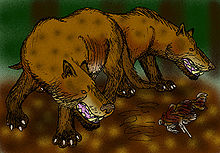- Megistotherium
-
Megistotherium
Temporal range: early Miocene 23.03–11.61 MaMegistotherium osteothlastes Scientific classification Kingdom: Animalia Phylum: Chordata Class: Mammalia Infraclass: Eutheria Superorder: Laurasiatheria Order: †Creodonta Family: Hyaenodontidae Subfamily: Hyainailourinae Genus: Megistotherium
Savage, 1973[1]Species: M. osteothlastes Synonyms - ?Hyainailouros Biedermann, 1863
Megistotherium (from Greek, megistos "greatest" + therion "beast" and osteon 'bone' + thlaston 'crushed, bruised' with -es being an agent noun: 'bone-crusher') is an extinct genus of creodonts, the only known species of which is Megistotherium osteothlastes.[2]. It is most likely a junior synonym of Hyainailouros sulzeri
Contents
Description
Megistotherium osteothlastes was an enormous hyaenodontid creodont that lived during the early Miocene Epoch some 23 million years ago. It has been found in the Ngorora Formation and Muruyur Formation Kenya, Egypt[3], Namibia, Uganda[4] and Libya. Named by Robert Savage in 1973,[2] it is one of the largest terrestrial carnivorous mammals known to have existed. It stood about 1.5 meters at the shoulders, 3.5 meters in the head and body length, 1 meter long tail and its skull was 65 cm long[5] and weighing 500 kg[6].
This can be compared to the other large carnivorous mammals; the current record holder Arctotherium (1700 kg; 3,4 meters; 10.000 years ago), Andrewsarchus (1000 kg; 3,4 meters; 40 million years ago), Polar bear (700 kg; 2,4 meters; now living) and Bengal tiger (260 kg; 3,1 meters; now living). The skull was twice as long as that of a Bengal tiger.
The carnassial teeth of Megistotherium (like those of other Creodonta) were the upper first molars, and overlapped with their lower molar counterparts like scissors to form a formidable and powerful shearing action. The land that is now the Sahara desert was much more fertile in the Miocene. A considerable amount of it was grassland and rainfall was plentiful. Lakes and ponds provided water for large fauna, which provided Megistotherium and other predators with an ample supply of prey. Large hyaenodontids like this one could have originally evolved as specialized predators or scavengers of large African herbivores.[7] Mastodon bones have been found with its fossils, indicating that Megistotherium may have hunted them for food.
Taxonomy
The order Creodonta comprised a diverse group of predators that were most successful during the Eocene before being ecologically displaced by the order Carnivora during the late Oligocene. Megistotherium emerged in the Miocene towards the end of the creodents flourishing; it was a part of a radiation of African hyaenodontids that occurred at that time. Hyainailouros sulzeri is very closely related to Megistotherium, extremely similar in size, structure and ratios - with a long tail, short limbs and robust body[8]. Morales & Pickford (2005)[9], Morlo, Miller & El-Barkooky (2007)[10] and Morales, Pickford & Salesa (2008)[11] suggested that Megistotherium is actually a junior synonym of Hyainailouros sulzeri, which is known by an almost complete skeleton[12], among other remains, and has been found in Europe, Asia and Namibia[13], and therefore comes from the same localities.
Notes
- ^ R. Savage, Megistotherium, gigantic hyaenodont from the Miocene of Gebel Zelten, Libya, Bull. Br. Mus. Nat. Hist. Geol. 22 (1973) 485–511.
- ^ a b "Megistotherium". Paleobiology Database. http://paleodb.org/cgi-bin/bridge.pl?action=checkTaxonInfo&taxon_no=40924&is_real_user=1. Retrieved January, 2010.
- ^ Morlo, M., Miller, E.R., and El-Barkooky, A.N. 2007. Creodonta and Carnivora from Wadi Moghra, Egypt. Journal of Vertebrate Paleontology 27: 145–159. doi:10.1671/0272-4634(2007)27[145:CACFWM]2.0.CO;2
- ^ MORALES, J. and M. PICKFORD. (2008). "Creodonts and carnivores from the Middle Miocene Muruyur Formation at Kipsaraman and Cheparawa, Baringo District, Kenya." Comptes Rendus Palevol 7 (8): 487-497
- ^ http://www.askabiologist.org.uk/answers/viewtopic.php?pid=863#p863
- ^ Sorkin, B. 2008: A biomechanical constraint on body mass in terrestrial mammalian predators. Lethaia, Vol. 41, pp. 333–347
- ^ Rasmussen, D. Tab; Tilden, Christopher D.; Simons, Elwyn L. (May, 1989). "New specimens of the giant creodont Megistotherium (Hyaenodontidae) from Moghara, Egypt". Journal of Mammalogy (American Society of Mammalogists) 70 (2): 442–447. http://www.jstor.org/pss/1381539.
- ^ Ginsburg, L. 1980. Hyainailouros sulzeri, mammifère créodonte du Miocène d’Europe. Ann. Paléont., 66, 19-73
- ^ Morales, J. and Pickford, M. 2005. Carnivores from the Middle Miocene Ngorora Formation (13-12 Ma) Kenya. Estudios Geol., 61, 271-284 http://digital.csic.es/bitstream/10261/2322/1/ngorora.pdf
- ^ Morlo, M., Miller, E.R., and El-Barkooky, A.N. 2007. Creodonta and Carnivora from Wadi Moghra, Egypt. Journal of Vertebrate Paleontology 27: 145–159.
- ^ MORALES J., PICKFORD M. & SALESA M. J. 2008. — Creodonta and Carnivora from the early Miocene of the northern Sperrgebiet, Namibia. Memoir of the Geological Survey of Namibia 20: 291-310
- ^ http://www.askabiologist.org.uk/answers/viewtopic.php?pid=863#p863
- ^ J. Morales, M. Pickford, S. Fraile, M.J. Salesa, D. Soria, Creodonta and Carnivora from Arrisdrift, early Middle Miocene of southern Namibia, Mem. Geol. Surv. Namibia 19 (2003) 177–194.
References
- Domning, D.P. (1978). "Sirenia." Evolution of African Mammals. pp. 573-581.
- Egi, Naoko. (2001). "Body Mass Estimates in Extinct Mammals from Limb Bone Dimensions: the Case of North American Hyaenodontids." Palaeontology. Vol. 44, Issue 3, Page 497.
- Leakey, L.S.B. and R.J.G. Savage (Editors). (1976). Fossil Vertebrates of Africa. Academic Press Inc.,U.S. ISBN 0124404049.
Categories:- Creodonts
- Miocene mammals
- Prehistoric mammals of Africa
- Megafauna of Africa
Wikimedia Foundation. 2010.

